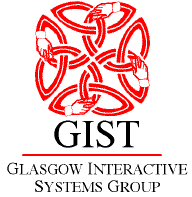 The Multimodal Interaction Group website has moved. Click here to visit the new site
The Multimodal Interaction Group website has moved. Click here to visit the new site
Earcon Experiments 2
Compound earcons
The previous page showed some hierarchical earcons. This page shows compound earcons (click here to find out more about them). Simply, two earcons are concatenated to produce a new, more complex earcon. You can download a HyperCard stack (400K) containing these earcons.
Figure 1: Open HyperCard compound earcon
Figure 1 shows a compound earcon for Open Hypercard. Click on the icon below to play the earcon. As compound earcons are made of two single earcons joined together the sound files are larger and so will take longer to download.
Figure 2: Print Write file 2 compound earcon
Figure 2 shows a compound earcon for Print Write file 2. Click on the icon below to play the earcon.
The two component earcons have a 0.1 second gap between them to help listeners tell where the first finishes and the second starts, otherwise the sounds are the same as those from the previous page.
Parallel earcons
The main drawback of compound, or serial, earcons as proposed by Blattner et al. [25] is that they can take a long time to play (2.6 seconds for the ones you have just heard). Interactions happen quickly and audio feedback must be able to keep pace with them. Each motive lasts a particular length of time depending on its notes and the tempo and these are then combined to produce longer compound earcons. Compound earcons could be played more rapidly (at a faster tempo) to overcome this problem but then errors in recognition may occur.One alternative method of overcoming this problem is to play the compound earcon at the same rate but pack the information more densely. This can be done by playing two earcons in parallel so that they only take the time of one to play. With parallel compound earcons the individual parameters can be left as they are for serial earcons but two sounds be played at the same time. Figure 3 gives an example of serial versus parallel compound earcons. We performed an experiment to investigate parallel earcons in more detail (see my publication list or a journal paper published on this topic for full detals).
Figure 3: Parallel versus serial compound earcons
If we use the same example as above:
Figure 3: Parallel earcon for Open HyperCard
Unfortunately, the reduced sound quality makes the parallel earcons difficult to hear. For the actual experiments we performed the sounds were much higher quality.
The results from our experiments showed that recall of parallel earcons was the same as for serial earcons under all conditions. We therefore showed that parallel earcons can be used to speed up the presentation of earcons.
Prof Stephen Brewster
Department of Computing Science,
University of Glasgow,
Glasgow, G12 8QQ, UK
Tel: +44 (0)141 330 4966
Fax: +44 (0)141 330 4913
Email: stephen@dcs.gla.ac.uk
Last Modified: December 29, 1998